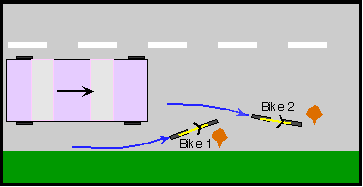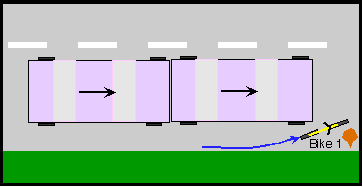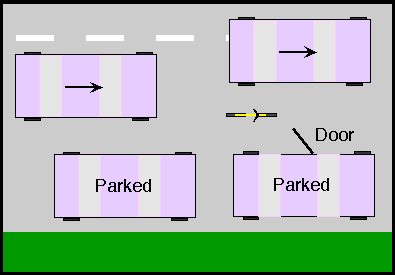|
4 Collision Avoidance
| contents:
4.1 Alertness
4.2 Bike Handling 4.3 Avoiding Obstructions 4.4 Bicycle Lanes 4.5 Near Misses 4.6 Technical Details |
Summary: The following provides an overview of what cyclists will do to avoid collisions in incidents that result from an error on the part of cyclists or motorists. There are a number of diagrams and most are drawn roughly to scale. The paths shown are based on calculations using elementary kinematics. A description of the mathematics is available in postscript form for interested parties.
Note: It is not possible to cover every possible situation that may occur. The following describes some situations that may occur, but is no an exhaustive treatment of every condition that a cyclist may face.
4.1 Alertness
Being aware of what others are doing may allow you to adjust to conditions before the situation requires some type of emergency manuever. Drivers should be aware that
- Cyclists can be riding faster than expected, with speeds ranging from under 10 mph to over 25 mph, depending on the type of bicycle and the physical conditioning of the cyclist.
- Cyclists cannot brake as well as cars can. Drivers preparing for a turn should be particularly careful about cutting off cyclists.
- Never tailgate a cyclist. The potential for a serious injury is too large.
- Give cyclists at least 3 to 5 feet of clearance when passing. A cyclist may have to avoid a small obstruction on the roadway that is hard to see in advance.
4.3 Avoiding Obstructions
Potholes and other obstacles are a fact of life. Expert cyclists will nominally stay far enough from a curb so that, if it is necessary to swerve to avoid an obstruction, they can swerve towards the curb. Normally, but not always, an obstruction 3 or more feet wide can be spotted well in advance (exceptions include glass or gravel that has the same color as the roadway).

In this figure, the blue lines represent the path of a bicycle. The bicycle labeled Bike 1 can avoid a pothole only be swerving into the path of an overtaking vehicle because you cannot swerve to the right when you are already by the curb. Bike 2 can swerve to the right to avoid the pothole. In the figure, Bike 2 was initially in the path of the vehicle (which would have had ample time to see this bicycle), although with a wider lane, there would have been room for both to proceed side by side. The cyclist riding Bike 2 is actually doing the following driver a favor, even though it would appear that the driver is being delayed: the real delay occurs when Bike 1 swerves and there is an accident. Even if there are no serious injuries, the paperwork can be daunting and time consuming.

Parked cars are an additional hazard that cyclists have to avoid. Doors will open unexpectedly, and riding far enough from parked cars to avoid being hit by an opening door is critical for safety.

The figure shows how a cyclist can proceed in a straight line, regardless of whether or not a car door opens. An overtaking vehicle can pass by crossing partially into the next lane if necessary (waiting, of course, until such a lane change can be made safely).
4.4 Bicycle Lanes
Drivers should expect cyclists to leave a bicycle lane at any time.
Cyclists may leave bicycle when riding as fast as other traffic, and my have to leave a bicycle lane under a variety of other circumstances, including passing slower cyclists and vehicles, preparing for a left turn, or approaching a place where a right turn is permitted.
Some bicycle lanes (usually older ones installed before the latest design standards were written) are too narrow for safety, with not enough clearance from parked cars, or are placed within right-turn-only lanes, or end by turning towards the curb. If a lane does not go where a cyclist is going, the cyclist will not use that lane, nor will a cyclist use the bicycle lane if using it puts the cyclist dangerously close to parked cars (whose doors can open at any time). In Section 21208, the California Vehicle Code grants permission to leave a bikelane, even when riding at a speed less than the normal speed of traffic, under all these circumstances.
4.5 Near Misses
The main thing that drivers can do to prevent a near miss from being an accident is to look carefully for bicycles when turning, changing lanes, or entering the roadway, and to change position slowly and carefully, giving cyclists plenty of time to react in the event that the driver did not see a cyclist. If all else fails, slow down as much as possible when the cyclist is ahead of the car. If the cyclist would most likely hit the rear of the car, slowing down may increase the chance of a collision, although it really depends on the situation.
|